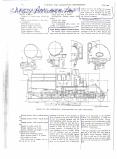
| Home | Open Account | Help | 380 users online |
|
Member Login
Discussion
Media SharingHostingLibrarySite Info |
Steam & Excursion > Amazingly, This Actually Is Not The End Of Line For This Engine!Date: 04/17/21 04:30 Amazingly, This Actually Is Not The End Of Line For This Engine! Author: LoggerHogger When noted California railfan, Stan Snook, of Fresno, California took a day away from his farm in July, 1937 to visit the not abandoned logging camp of Sugar Pine, California to see what was left of the Madera Sugar Pine Lumber Company logging railroad, this is one of the sights he came across. While it would have been understandable to think the the scrappers were starting to scrap MSP 3-truck Shay #5, that is not what is happening here.
Actually,MSP #5 has been sold by the scrappers to the Diamond & Caldor Lumber Company of Diamond Springs, California. The D&C need spare parts for their narrow gauge Shays on their logging railroad and #5 fit the bill. The D&C purchased only the locomotive part of #5 and not the 3rd truck and tender. The parts they harvest off #5 will help keep the D&C Shays in service until 1951 when that operation is finally shut down when the State inspector discovered them still using the long-outlawed link & pin coupler system on all thier equipment. Martin Edited 5 time(s). Last edit at 04/17/21 04:39 by LoggerHogger.  Date: 04/17/21 11:20 Re: Amazingly, This Actually Is Not The End Of Line For This Engi Author: PlyWoody Martin
Martin, Why do you say this? You are an attorney and it is fake news. "D&C Shays in service until 1951 when that operation is finally shut down when the State inspector discovered them still using the long-outlawed link & pin coupler system on all their equipment." At that date New York State was the only state that required Janney coupler and that state law was before the Safety Appliance Act of 1893. It has never been illegal to have link and pin coupler on any locomotives as that 1893 SAA law only required automatic coupler on cars that carry commerce in interstate or foreign transportation. The judges in several court have had to explain to the jury that locomotives do not carry commerce and are not covered by that law. A later California State Law outlawed link and pin coupling but not at that date. The late Jerry Fisher confirmed to me that locomotives have never been specified as to what type of coupler is legal or not legal. He was the FTA employee who handled and authorized any requested exemption to FRA rules, and this was his training of the law. Date: 04/17/21 14:12 Re: Amazingly, This Actually Is Not The End Of Line For This Engi Author: LoggerHogger Once again, you are wrong. The Diamond & Caldor was still a common carrier railroad in 1951 and was subject to the Railway Appliances Safety Act. They just had not been caught until 1951 when the inspector came around.
Martin Date: 04/17/21 16:53 Re: Amazingly, This Actually Is Not The End Of Line For This Engi Author: PlyWoody The Diamond & Caldor even if they are common-carrier can run non-compliance cars on their railroad and still be legal without California shutting them down. The Somerset Railroad in Maine operated 300 link and pin log bunk cars over their common-carrier railroad that operated passenger trains to resorts on the Moosehead Lake. In both cases the cars carried private company material that was not waybilled with a tariff. It is the nature of the traffic as to what jurisdiction would take effect. The Federal SAA never had jurisdiction over the traffic of logging railroad that only hauled their log and did not haul interchange revenue way-billed shipments. In many cases there were "tap Lines" that both handled compliance and non-compliant traffic.
The D&C made it all those years without any contest until some new greenhorn state official decided to make his own understanding of the law. I include a article identifying the locomotive to not being covered by SAA account it does not carry commerce from Ry & Engineering Journal.  Date: 04/17/21 17:01 Re: Amazingly, This Actually Is Not The End Of Line For This Engi Author: LoggerHogger You cite a 1902 engineering article. The court cases on the act are what control and there were many in the 50 years after your article the interpreted the act to outlaw the link & pin couplers on common carriers.
Martin |